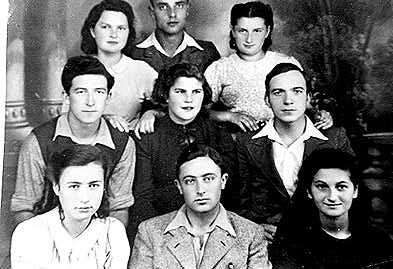
|
Under Soviet Rule.
In June 1940 Lithuania was annexed by the Soviet Union and became a Soviet Republic. The president of the Lithuanian Smetona together with many of his friends, escaped to Germany via Kibart.
A border guard unit of the Red Army arrived in Kibart and was put up in the buildings of the railway workers at the corner of Vishtinetz street. Russian soldiers stormed the shops, buying everything they saw. Goods lying in the storerooms without use were brought into the shops and sold for good money.
At the end of July the banks were nationalized and deposits frozen. At first one was allowed to draw 1,000 Ruble per month per family, later this sum were gradually reduced to 250 Ruble. Then those industries for which the following criteria applied were nationalized, i.e. " a factory which employs more than 20 workers or a factory where a minimum of 10 workers are employed, which uses mechanical power and whose products are important for some other factory."
In Kibart most of the Jewish factories were nationalized, commissars installed and appointed as their directors. These were communists who had been freed from jails or those who had been active in the communist underground, among them several local Jews. At the beginning of August commissars were appointed to such shops as Shadchanovitz, Sinenesky and others, whose annual turnover was above 150,000 Lit.
The owners of the factories and shops became clerks and salesmen in their own enterprises, being responsible to the commissars who kept the keys of the enterprises and of the cash.
Since they had no managing experience, they were helped by the former owners during the year of Soviet rule before the war.
Russian single officers and officers' families of the border guard were accommodated in private flats in the nicer buildings, where mostly Jewish families were living.
The supply of goods diminished and as a result prices gradually rose. The middle class, mostly Jewish, was badly hurt and its living standard decreased gradually, also wage earners hardly made a living.
During the school year of 1940/41 the Hebrew school became a Jewish school, with Yiddish as the teaching language. Its headmaster A.Warshavsky was dismissed and sent to Kupishok as a teacher, and the school was now directed by teachers Sheine Halperin and Mordechai Lurie. The Zionist Youth Organizations were dispersed and the Comsomol - the Communist Youth Organization - started to mobilize new members.
Some "Shaulists" - a nationalist Lithuanian organization of ex- army soldiers - and among them some Zionist activists, were arrested, as were some Jewish traders in foreign currency and also people who had been slandered for different wrongdoings.
A tense and fearful atmosphere prevailed and people were afraid of what the morrow would bring. Add to that the rumors, which were spread deliberately, that after the division of Poland between Russia and Germany in accordance with the Ribbentrop-Molotov treaty, Lithuania too would be divided, with Kibart and its environs being annexed by Germany.
According to this treaty all Germans without any exception, who until then lived in Lithuania, were repatriated, and since many Germans lived in Kibart and its surroundings their departure added to the tense atmosphere.
In the middle of June 1941, the authorities started to send families of owners of the nationalized factories, shops and houses, also those suspected of Zionist activity, to exile deep in the USSR. Only a few hours notice was given, during which those doomed to exile had to pack their belongings which were limited in quantity, and were then taken to the freight wagons.
From Kibart Chaim Miltz with his wife and daughter, Michael Shadchanovitz, his wife and son, Rachlin and his wife, Berniker and his wife and two sons, were exiled.
Broadcasts from the B.B.C. in London about the "Eastern Front" and news about the concentration of the German army along the borders of the USSR, did not cause a strong enough impact among Kibart's Jews to make them take their belongings and escape away from the German border as far as possible. One could possible explain this state of mind by the tense atmosphere and the uncertainty which paralyzed every ability to decide. In addition there was the strong belief in the might of the Red Army which propaganda had managed to implant in the minds of most Jews.

On the upper line from right: Y. Levin, -----, S. B. Zilbersky.
On the middle line: myself, Miriam Rotenberg, Aryeh Leibovitz.
On the lower line: R. Vilensky, M.Chlamnovitz, Levinsky (?)
|
JewishGen, Inc. makes no representations regarding the accuracy of
the translation. The reader may wish to refer to the original material
for verification.
JewishGen is not responsible for inaccuracies or omissions in the original work and cannot rewrite or edit the text to correct inaccuracies and/or omissions.
Our mission is to produce a translation of the original work and we cannot verify the accuracy of statements or alter facts cited.
 Kibart (Kybartai), Lithuania
Kibart (Kybartai), Lithuania
 Yizkor Book Project
Yizkor Book Project
 JewishGen Home Page
JewishGen Home Page
Copyright © 1999-2026 by JewishGen, Inc.
Updated 13 Mar 2003 by LA